2013 Peugeot 508 RXH 4 wheel drive
[x] Cancel search: 4 wheel drivePage 6 of 308
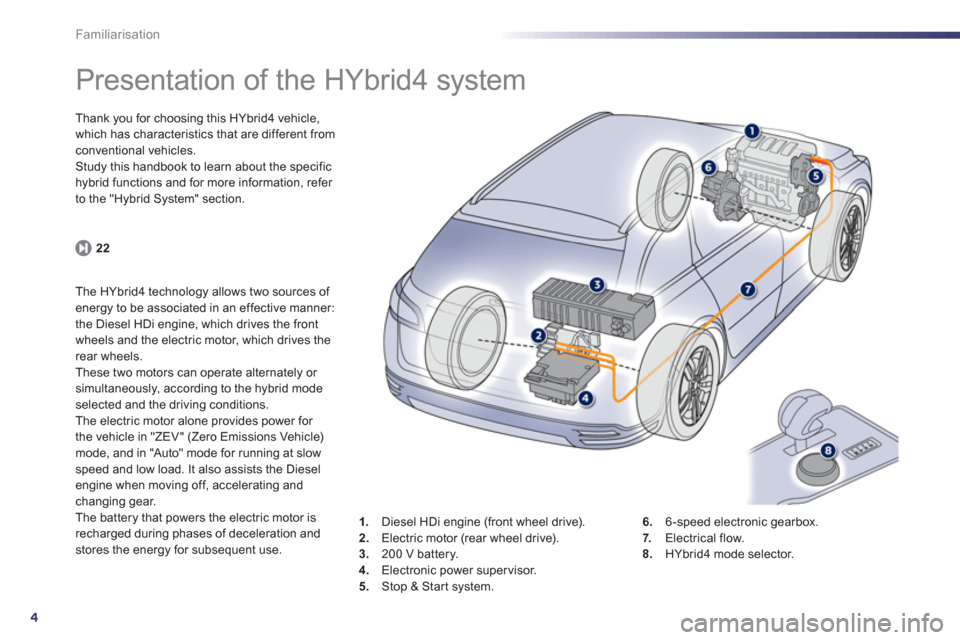
4
Familiarisation
Presentation of the HYbrid4 system
Thank you for choosing this HYbrid4 vehicle,
which has characteristics that are different from conventional vehicles.
Study this handbook to learn about the specific hybrid functions and for more information, refer
to the "Hybrid System" section.
22
The HYbrid4 technology allows two sources of energy to be associated in an effective manner:
the Diesel HDi engine, which drives the front
wheels and the electric motor, which drives the
rear wheels.
These two motors can operate alternately or simultaneously, according to the hybrid modeselected and the driving conditions.
The electric motor alone provides power for
the vehicle in "ZEV" (Zero Emissions Vehicle) mode, and in "Auto" mode for running at slowspeed and low load. It also assists the Dieselengine when moving off, accelerating and changing gear.
The battery that powers the electric motor is
recharged during phases of deceleration andstores the energy for subsequent use.1
.Diesel HDi engine (front wheel drive). 2. Electric motor (rear wheel drive).3.
200 V battery.4.Electronic power supervisor.
5.Stop & Start system. 6
.6 -speed electronic gearbox.7. Electrical flow. 8.HYbrid4 mode selector.
Page 14 of 308

12
Familiarisation
11.Front door window demisting/defrostingvent.
12.Windscreen demisting/defrosting vent.
13
. Steering lock and star ting with the key. 14 .
Starting using the electronic key.
15. Audio equipment steering wheel controls.
16.Wiper / screenwash / trip computer stalk.
17. Central locking and hazard warningbuttons.
18. Screen.
19.Central adjustable air vents.
20.Passenger's airbag. 21. Side adjustable air vents.
Instruments and controls
1.
Cruise control / speed limiter controls. 2.
Headlamp height adjustment. 3.
Lighting and direction indicator stalk
4.
Instrument panel. 5.
Driver's airbag.Horn.
6.Gear selector.
7. HYbrid4 mode selector. 8.12 V accessory socket
USB por t / auxiliary socket. 9. Bonnet release lever.10.Fusebox.
22.
Glove box / Passenger's airbag deactivation. 23.
Electric parking brake.
24.
Central armrest with storage. 25.Storage (according to version).26.Audio system. 27.
Heating / air conditioning controls.28.
Alarm / Peugeot Connect SOS - PeugeotConnect Assistance. 29.
Peugeot Connect Navigation (RT6)controls. 30.
Massage / Adaptive lighting / Parkingspace sensor.
Page 24 of 308

22
Hybrid system
Presentation
energy to be associated in an effective manner:
the Diesel HDi engine, which drives the front
wheels and the electric motor, which drives the rear wheels.These two motors can operate alternately or simultaneously, according to the hybrid modeselected and the driving conditions.
The electric motor alone provides power for
the vehicle in "ZEV" (Zero Emissions Vehicle) mode, and in "Auto" mode for running at slowspeed and low load. It also assists the Dieselengine when moving off, accelerating and changing gear.The battery that powers the electric motor is recharged during phases of deceleration andstores the energy for subsequent use.
1.Diesel HDi engine (front wheel drive). 2. Electric motor (rear wheel drive).3.
200 V battery.4.Electronic power supervisor.
5
.Stop & Start system. 6
.6 -speed electronic gearbox.7. Electrical flow. 8.HYbrid4 mode selector.
Page 25 of 308

.
23
Hybrid system
Main parts of the HYbrid4 system
The HDi Diesel engine - 1
, located at the front, drives the front wheels and provides most of the power needed to drive the vehicle.
It is fitted with the Stop & Start
system - 5
which recharges the batteries and provides additional
power when needed (in 4x4 mode).
Th
e electric motor - 2
, located at the rear, drives the rear wheels on its own, or supplements the
Diesel engine, according to the hybrid mode selected.
It recovers energy and charges the batteries during phases of deceleration of the vehicle and is
active up to 70 mph (120 km / h).
A 200 V NI-MH high voltage battery - 3
, provides a source of energy for the rear electric motor.
Its charging rate is managed automatically by the vehicle during phases of deceleration.
It is located in a compar tment in the boot, access to which is restricted to trained service
technicians.
The batter
y state of chargeis indicated by 8 horizontal or vertical bars (depending on the screen).
The conventional battery, located under the bonnet, powers the vehicle's 12 V systems. It is yrecharged automatically by the high voltage network.
Page 26 of 308
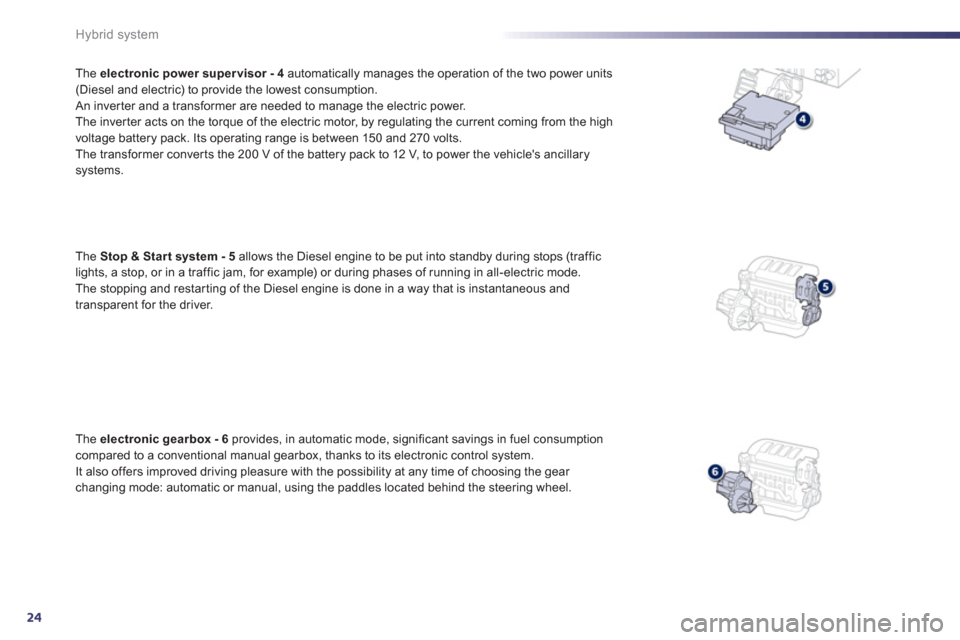
24
Hybrid system
The electronic power super visor - 4automatically manages the operation of the two power units(Diesel and electric) to provide the lowest consumption.
An inver ter and a transformer are needed to manage the electric power.
The inver ter acts on the torque of the electric motor, by regulating the current coming from the high
voltage battery pack. Its operating range is between 150 and 270 volts.
The trans
former conver ts the 200 V of the battery pack to 12 V, to power the vehicle's ancillary
systems.
Th
e Stop & Star t system - 5
allows the Diesel engine to be put into standby during stops (traffic
lights, a stop, or in a traffic jam, for example) or during phases of running in all-electric mode.
The stopping and restar ting of the Diesel engine is done in a way that is instantaneous and
transparent for the driver.
Th
e electronic gearbox - 6provides, in automatic mode, significant savings in fuel consumption compared to a conventional manual gearbox, thanks to its electronic control system.
It also offers improved driving pleasure with the possibility at any time of choosing the gear changing mode: automatic or manual, using the paddles located behind the steering wheel.
Page 32 of 308
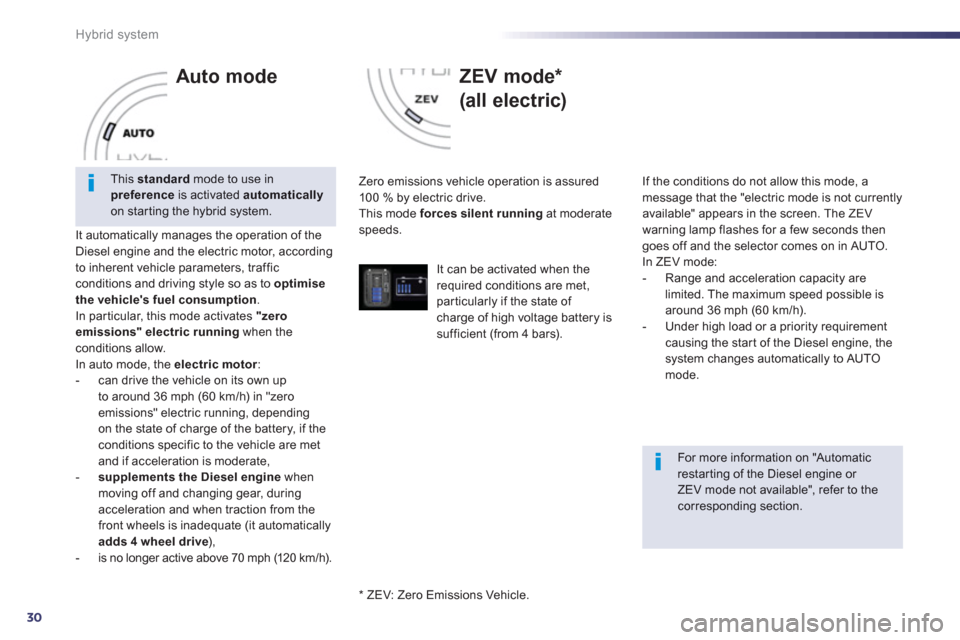
30
Hybrid system
Auto mode
It automatically manages the operation of the
Diesel engine and the electric motor, according
to inherent vehicle parameters, traffic
conditions and driving style so as to optimise
the vehicle's fuel consumption.In par ticular, this mode activates "zero emissions" electric runningwhen theconditions allow.
In auto mode, the electric motor
:
- can drive the vehicle on its own up
to around 36 mph
(60 km/h) in "zero
emissions" electric running, dependingon the state of charge of the battery, if the conditions specific to the vehicle are metand if acceleration is moderate, -supplements the Diesel enginewhen moving off and changing gear, during acceleration and when traction from thefront wheels is inadequate (it automaticallyadds4 wheel drive ),
- is no longer active above 70 mph (120 km / h).
ZEV mode *
(all electric)
Zero emissions vehicle operation is assured
10 0 % by electric drive.
This mode forces silent runningat moderatespeeds.
If the conditions do not allow this mode
, amessage that the "electric mode is not currentlyavailable" appears in the screen. The ZEV
warning lamp flashes for a few seconds then
goes off and the selector comes on in AUTO.
In ZEV mode:
- Range and acceleration capacity are
limited. The maximum speed possible is
around 36 mph (60 km/h).
- Under high load or a priority requirement causing the star t of the Diesel engine, thesystem changes automatically to AUTO mode.
This standard
mode to use inpreferenceis activated automaticallyon star ting the hybrid system.
For more information on "Automaticrestarting of the Diesel engine or ZEV mode not available", refer to the corresponding section.
*
ZEV: Z
ero Emissions Vehicle.
It can be activated when therequired conditions are met, particularly if the state of charge of high voltage battery is sufficient (from 4 bars).
Page 33 of 308
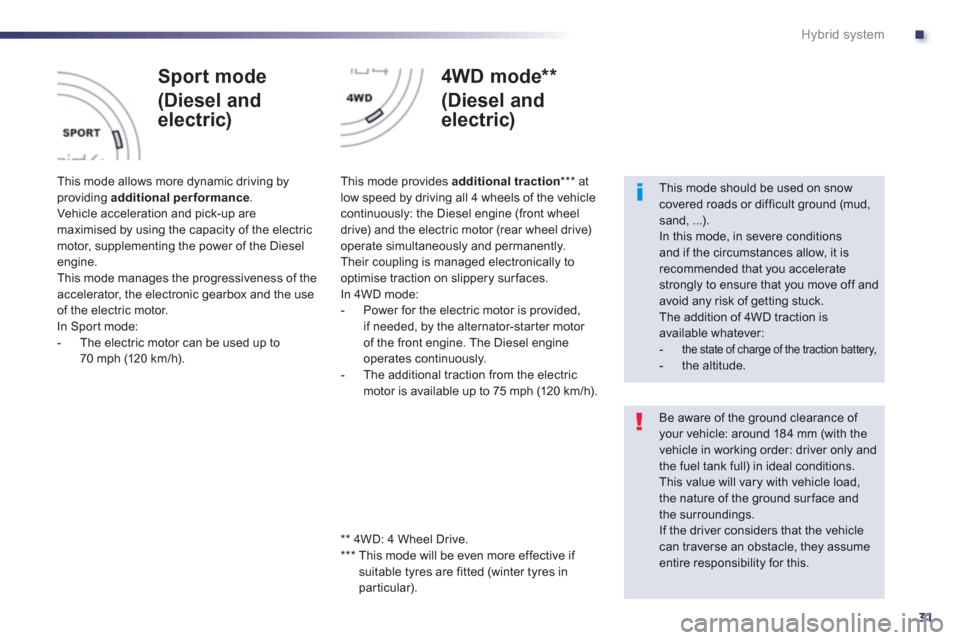
.
31
Hybrid system
Sport mode
(Diesel and
electric)
This mode allows more dynamic driving byproviding additional performance. Vehicle acceleration and pick-up aremaximised by using the capacity of the electricmotor, supplementing the power of the Dieselengine.
This mode manages the progressiveness of the
accelerator, the electronic gearbox and the useof the electric motor.
In Spor t mode:
-
The electric motor can be used up to
70 mph (120 km/h).
4WD mode **
(Diesel and
electric)
This mode provides additional traction*** at low speed by driving all 4 wheels of the vehiclecontinuously: the Diesel engine (front wheel
drive) and the electric motor (rear wheel drive)
operate simultaneously and permanently.
Their couplin
g is managed electronically to
optimise traction on slippery surfaces.
In 4WD mode:
- Power for the electric motor is provided,
if needed, b
y the alternator-star ter motor
of the front engine. The Diesel engine
operates continuously.
- The additional traction from the electric
motor is available up to 75 mph (120 km/h).
This mode should be used on snow covered roads or difficult ground (mud,sand, ...).
In this mode, in severe conditions and if the circumstances allow, it is recommended that you accelerate strongly to ensure that you move off and avoid any risk of getting stuck.
The addition of 4WD traction isavailable whatever:
- the state of charge of the traction battery,
- the altitude.
Be aware of the ground clearance of your vehicle: around 184 mm (with the vehicle in working order: driver only and the fuel tank full) in ideal conditions.
This value will vary with vehicle load,the nature of the ground surface and the surroundings.
If the driver considers that the vehicle
can traverse an obstacle, they assumeentire responsibility for this.
**
4WD: 4 Wheel Drive.
***
This mode will be even more effective if suitable tyres are fitted (winter tyres in
particular
).
Page 35 of 308
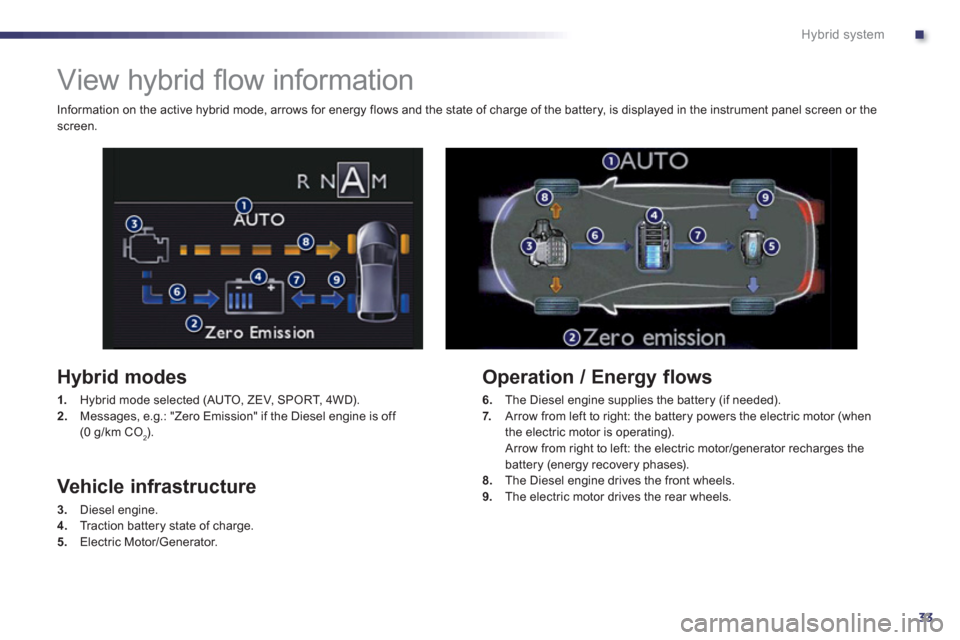
.
33
Hybrid system
View hybrid fl ow information
Hybrid modes
1.
Hybrid mode selected (AUTO, ZEV, SPORT, 4WD). 2.Messages, e.g.: "Zero Emission" if the Diesel engine is off (0 g/km CO2).
Vehicle infrastructure
3.Diesel engine.4.
Tr a c t i o n b a t t e ry state of charge.
5. Electric Motor/Generator.
Operation / Energy flows
6.
The Diesel engine supplies the battery (if needed).
7.Arrow from left to right: the battery powers the electric motor (when
the electric motor is operating).
Arrow from right to left: the electric motor/generator recharges the
battery (energy recovery phases).8. The Diesel engine drives the front wheels. 9.The electric motor drives the rear wheels. Information on the active h
ybrid mode, arrows for energy flows and the state of charge of the battery, is displayed in the instrument panel screen or the screen.